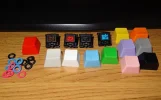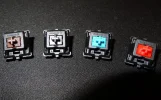- Joined
- Jan 31, 2005
- Messages
- 13,573
- Reaction score
- 1,888
Just been reading this guide regarding Mech Keyboards. Very interesting!
This is one of the things i really want, but cant or don't want to part with my beloved G19.
I shall only post part of the guide here as you should really go and read it for yourself.
http://www.overclock.net/t/491752/mechanical-keyboard-guide
This is one of the things i really want, but cant or don't want to part with my beloved G19.
I shall only post part of the guide here as you should really go and read it for yourself.

http://www.overclock.net/t/491752/mechanical-keyboard-guide
Fact: Nearly all keyboards sold bundled with computers or at retail stores use rubber domes under their keys. This is the same technology used in cheap TV remotes. They're made to be as cheap as possible to manufacture in order to maximize profits. Yes, this even includes "high end" keyboards. So why settle for something that is made as cheap as possible?
So Why do YOU want a Mechanical Keyboard?
For most people it's all about the feel. With the keyboard you're typing on right now you've got to press the key all the way down to the bottom to get it to register. This wastes a lot of energy and causes fatigue, as most of your effort is spent pushing against a solid piece of plastic. Mechanical keyswitches are designed so that they register before you bottom out, so you only need to apply as much force as is necessary to actuate it, not wasting any. And with as many different types of switches as there are you can pick and choose which one you're the most comfortable with, as each one has a different feel to it. And most people who try one can never go back to using rubber domes, as they realize just how "mushy" they really feel.
Common Key Switches
Introduction - A Switch is Not "Just a Switch"
Many people ask for recommendations about switches without knowing exactly what they are looking for, but instead only with an idea of what their needs are. Fortunately, this is not always a problem because most mechanical switches will always feel nicer than rubber domes. However, the final choice is very important because a switch is not just a switch; it is the heart of what makes your keyboard have its feel and your personal tastes can make or break a keyboard for your uses. If you don't like the switch when you type on it, most likely, you won't ever like the keyboard.
Switches are generally rated by force using the weight measurement of Grams (g). Although force is more accurately described using Centinewtons (cN) However, 1g of weight applies about 1cN of downward force, so we can use "55g" when describing a 55cN-rated switch because that is sometimes easier to understand. For this fact; we'll use Grams as a measurement of force; though either term is correct.
For perspective, it would be wise to remember that your average rubber dome keyboard requires between 55g and 60g of force to actuate.
Cherry MX Black Switches

Type: Linear Switch
Link: Datasheet
Tactile: No
Clicky: No
Actuation Force: 60g (40g-80g overall) (Force Diagram)
Key Travel: 2mm to actuation, 4mm to bottomCherry MX-Black switches are linear (non-tactile) switches, these are considered one of the best switch types for gaming. When gaming, having a tactile bump does absolutely nothing because you're going to be bottoming out anyway. So these give you a very smooth feel. The actuation and release points are at the exact same position as well. So games that require a lot of double tapping become easier than on any other keyswitch. However, most people don't enjoy typing on them that much do in part, to their linear nature. If you're a person who tends to hit a wrong key every so often while gaming, these will be beneficial in that the high actuation force will help prevent many of those accidental presses.
Cherry MX Brown Switches

Type: Tactile Switch
Link: Datasheet
Tactile: Yes
Clicky: No
Actuation Force: 45g (55g Peak Force) (Force Diagram)
Key Travel: 2mm to actuation, 4mm to bottomCherry MX Brown switches are considered a middle ground between typing and "gaming" switches. They have a light, tactile feel half way through the key press that lets you know the switch has activated. This gives you an indication of what you can release the switch. The switch is considered a middle ground because the reset point & actuation point are close enough together than you can "float" at that point, enabling you to double tap faster.
As a note: this switch actually has a peak force of 55G, it is 45G at the point of actuation. This is due to the design of the Cherry switch itself.
Cherry MX Blue Switches

Type: Tactile & Clicky Switch
Link: Datasheet
Tactile: Yes, precise
Clicky: Yes
Actuation Force: 50g (60g Peak Force) (Force Diagram)
Key Travel: 2mm to actuation, 4mm to bottomCherry MX Blue switches are the best cherry switch for typing. The tactile bump can easily be felt, and the resistance is similar to your average keyboard.
Although many people find them just fine for gaming, some don't like the fact that the release point is above the actuation point. This can cause some trouble with double-tapping. This is usually the case with someone who has experienced other mechanical switches before hand.
As a note: this switch actually has a peak force of 60g, it is 50g at the point of actuation. This is due to the design of the Cherry switch itself.
Cherry MX Clear Switches

Type: Tactile Switch
Link: Datasheet
Tactile: Yes
Clicky: No
Actuation Force: 55g (65G peak force) (Force Diagram)
Key Travel: 2mm to actuation, 4mm to bottomCherry MX Clear switches have often been called "stiffer browns" though some users note that they have more of a tactile feel than browns do. This really can be a subjective topic, though this is another switch that could be considered "ballanced." The force required is comparable to most rubber dome keyboards, with a nice tactile feedback to tell you the key has actuated. These switches are harder to find on keyboards.
As a note: this switch actually has a peak force of 65g, it is 55g at the point of actuation. This is due to the design of the Cherry switch itself.
Cherry MX Red Switches

Type: Linear Switch
Link: Datasheet
Tactile: No
Clicky: No
Actuation Force: 45g (Force Diagram)
Key Travel: 2mm to actuation, 4mm to bottomCherry MX-Red's are another switch that can be considered a "gaming" switch. It's essentially a lighter version of the MX Black, requiring less force to actuate. Some people do not find this switch that good for typing or gaming because it is so light, but others rave for this fact. Light or Stiff is always a matter of preference. This switch was hard to find; and was reported as EOL, but it is still in limited production with a higher than average MOQ leading to higher cost to board makers. Marketed with high demand, boards with this switch are becoming more common, but are generally more expensive as well.

 Though now I've ordered it what's the betting if I looked again I'd find it!?
Though now I've ordered it what's the betting if I looked again I'd find it!?





